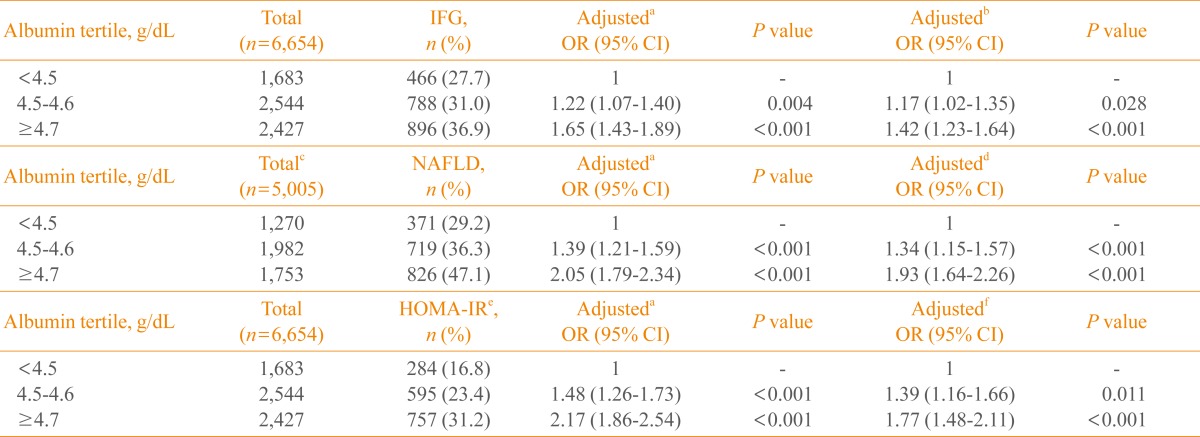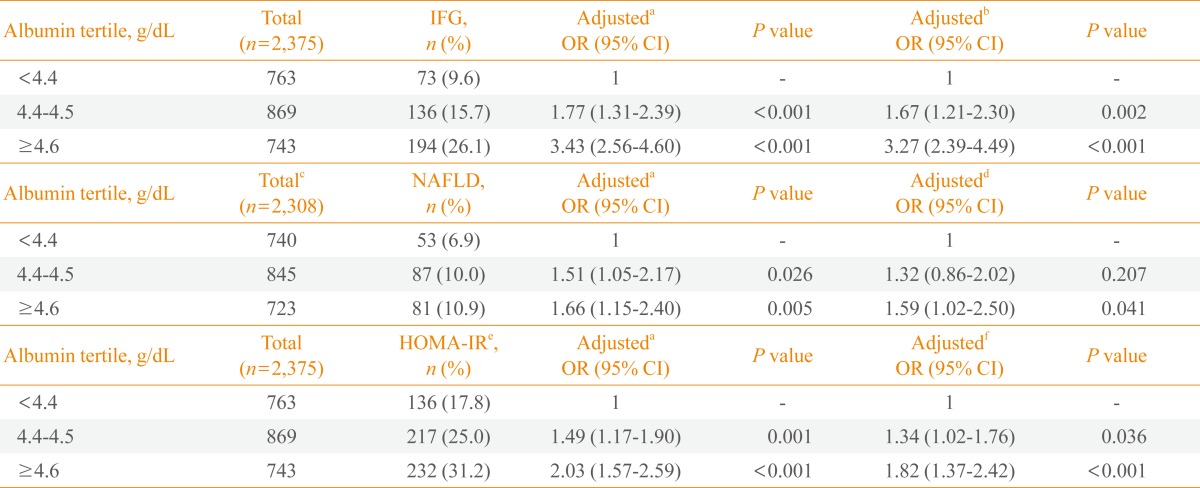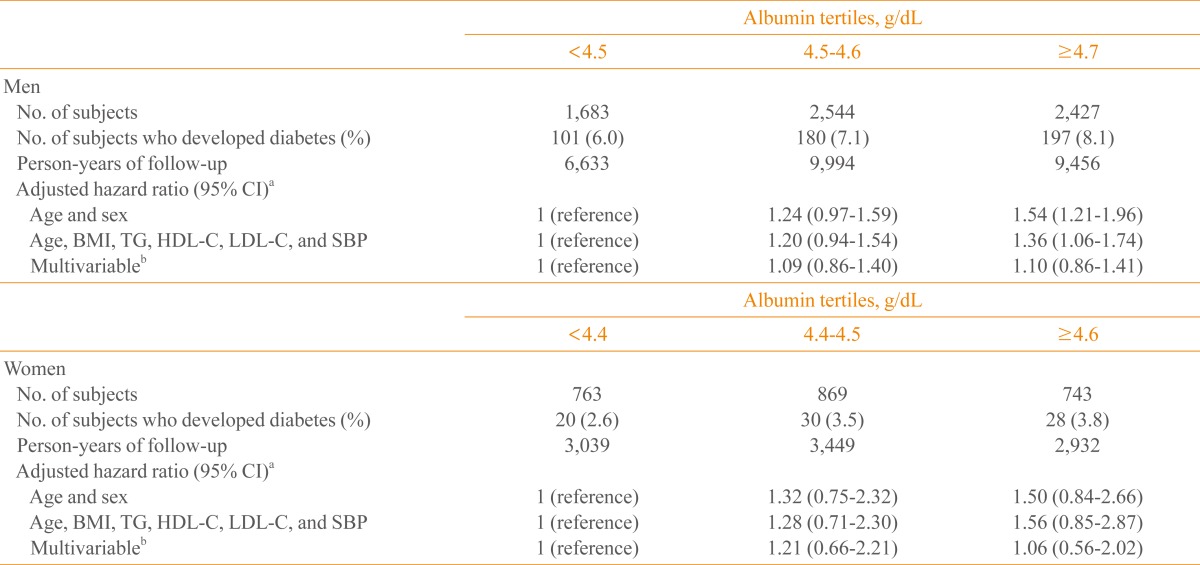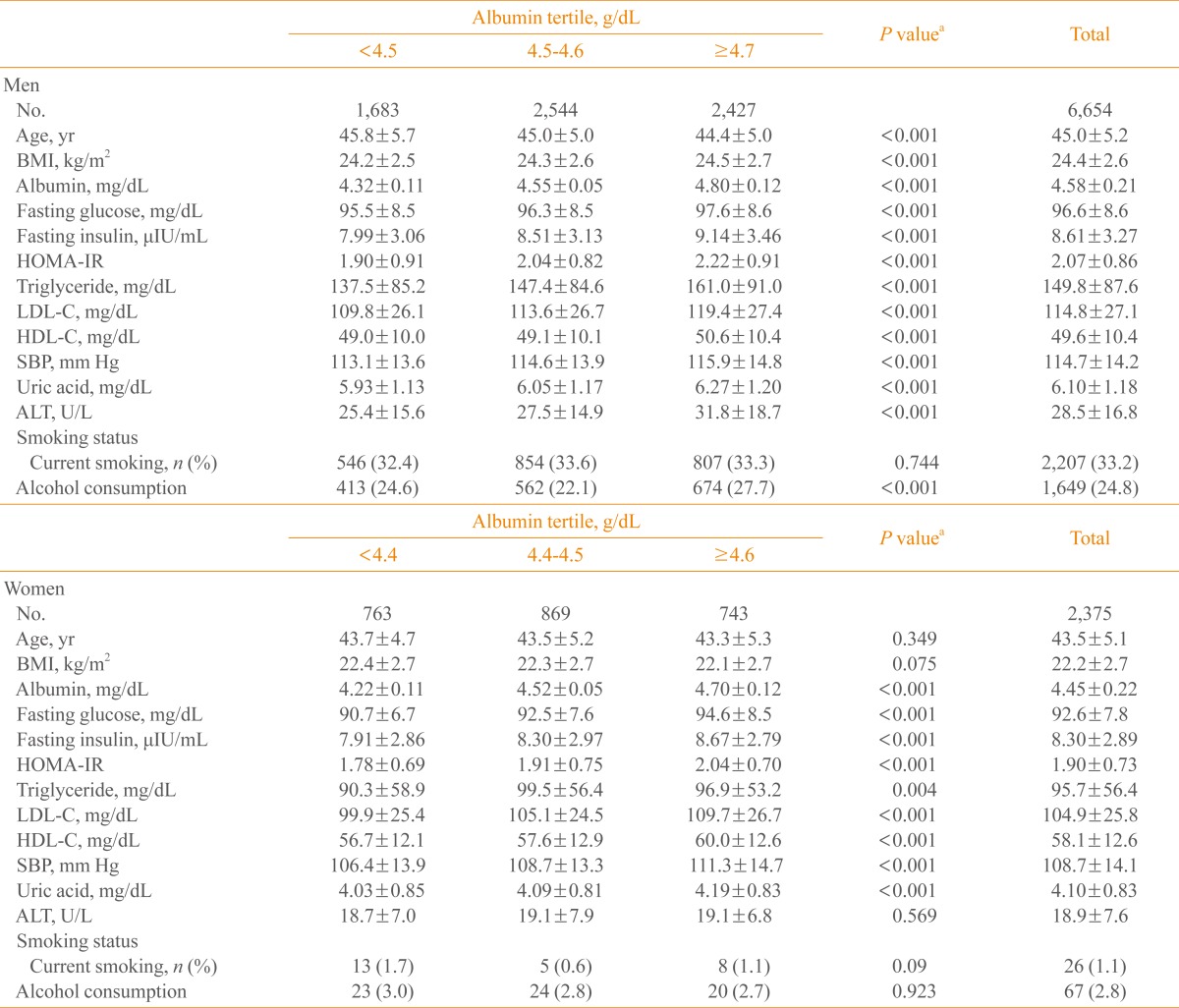1. Doweiko JP, Nompleggi DJ. The role of albumin in human physiology and pathophysiology. Part III: albumin and disease states. JPEN J Parenter Enteral Nutr. 1991; 15:476–483. PMID:
1895489.
2. Kaysen GA. Biological basis of hypoalbuminemia in ESRD. J Am Soc Nephrol. 1998; 9:2368–2376. PMID:
9848794.

3. Yamanaka H, Nishi M, Kanemaki T, Hosoda N, Hioki K, Yamamoto M. Preoperative nutritional assessment to predict postoperative complication in gastric cancer patients. JPEN J Parenter Enteral Nutr. 1989; 13:286–291. PMID:
2503639.

4. Seiler WO. Clinical pictures of malnutrition in ill elderly subjects. Nutrition. 2001; 17:496–498. PMID:
11517898.

5. Kadono M, Hasegawa G, Shigeta M, Nakazawa A, Ueda M, Yamazaki M, Fukui M, Nakamura N. Serum albumin levels predict vascular dysfunction with paradoxical pathogenesis in healthy individuals. Atherosclerosis. 2010; 209:266–270. PMID:
19819455.

6. Ishizaka N, Ishizaka Y, Nagai R, Toda E, Hashimoto H, Yamakado M. Association between serum albumin, carotid atherosclerosis, and metabolic syndrome in Japanese individuals. Atherosclerosis. 2007; 193:373–379. PMID:
16904116.

7. Djousse L, Rothman KJ, Cupples LA, Levy D, Ellison RC. Serum albumin and risk of myocardial infarction and all-cause mortality in the Framingham Offspring Study. Circulation. 2002; 106:2919–2924. PMID:
12460872.

8. Halliwell B. Albumin: an important extracellular antioxidant? Biochem Pharmacol. 1988; 37:569–571. PMID:
3277637.
9. Zoellner H, Hofler M, Beckmann R, Hufnagl P, Vanyek E, Bielek E, Wojta J, Fabry A, Lockie S, Binder BR. Serum albumin is a specific inhibitor of apoptosis in human endothelial cells. J Cell Sci. 1996; 109(Pt 10):2571–2580. PMID:
8923218.

10. Zhang WJ, Frei B. Albumin selectively inhibits TNF alpha-induced expression of vascular cell adhesion molecule-1 in human aortic endothelial cells. Cardiovasc Res. 2002; 55:820–829. PMID:
12176131.
11. Ceriello A, Motz E. Is oxidative stress the pathogenic mechanism underlying insulin resistance, diabetes, and cardiovascular disease? The common soil hypothesis revisited. Arterioscler Thromb Vasc Biol. 2004; 24:816–823. PMID:
14976002.

12. Wellen KE, Hotamisligil GS. Inflammation, stress, and diabetes. J Clin Invest. 2005; 115:1111–1119. PMID:
15864338.

13. Bugianesi E, Gastaldelli A, Vanni E, Gambino R, Cassader M, Baldi S, Ponti V, Pagano G, Ferrannini E, Rizzetto M. Insulin resistance in non-diabetic patients with non-alcoholic fatty liver disease: sites and mechanisms. Diabetologia. 2005; 48:634–642. PMID:
15747110.

14. Bae JC, Cho YK, Lee WY, Seo HI, Rhee EJ, Park SE, Park CY, Oh KW, Sung KC, Kim BI. Impact of nonalcoholic fatty liver disease on insulin resistance in relation to HbA1c levels in nondiabetic subjects. Am J Gastroenterol. 2010; 105:2389–2395. PMID:
20628364.

15. Abdul-Ghani MA, Tripathy D, DeFronzo RA. Contributions of beta-cell dysfunction and insulin resistance to the pathogenesis of impaired glucose tolerance and impaired fasting glucose. Diabetes Care. 2006; 29:1130–1139. PMID:
16644654.
16. Ikeda Y, Suehiro T, Nakamura T, Kumon Y, Hashimoto K. Clinical significance of the insulin resistance index as assessed by homeostasis model assessment. Endocr J. 2001; 48:81–86. PMID:
11403106.

17. Hostmark AT, Tomten SE, Berg JE. Serum albumin and blood pressure: a population-based, cross-sectional study. J Hypertens. 2005; 23:725–730. PMID:
15775775.
18. Danesh J, Muir J, Wong YK, Ward M, Gallimore JR, Pepys MB. Risk factors for coronary heart disease and acute-phase proteins. A population-based study. Eur Heart J. 1999; 20:954–959. PMID:
10361047.

19. Saito I, Yonemasu K, Inami F. Association of body mass index, body fat, and weight gain with inflammation markers among rural residents in Japan. Circ J. 2003; 67:323–329. PMID:
12655163.

20. Kahn CR. Banting Lecture. Insulin action, diabetogenes, and the cause of type II diabetes. Diabetes. 1994; 43:1066–1084. PMID:
8039601.
21. Shanik MH, Xu Y, Skrha J, Dankner R, Zick Y, Roth J. Insulin resistance and hyperinsulinemia: is hyperinsulinemia the cart or the horse? Diabetes Care. 2008; 31(Suppl 2):S262–S268. PMID:
18227495.
22. Reaven GM. Pathophysiology of insulin resistance in human disease. Physiol Rev. 1995; 75:473–486. PMID:
7624391.

23. Lloyd CE, Kalinyak JE, Hutson SM, Jefferson LS. Stimulation of albumin gene transcription by insulin in primary cultures of rat hepatocytes. Am J Physiol. 1987; 252(2 Pt 1):C205–C214. PMID:
3548414.

24. Peavy DE, Taylor JM, Jefferson LS. Time course of changes in albumin synthesis and mRNA in diabetic and insulin-treated diabetic rats. Am J Physiol. 1985; 248(6 Pt 1):E656–E663. PMID:
3890555.

25. Kimball SR, Horetsky RL, Jefferson LS. Hormonal regulation of albumin gene expression in primary cultures of rat hepatocytes. Am J Physiol. 1995; 268(1 Pt 1):E6–E14. PMID:
7840183.

26. De Feo P, Gaisano MG, Haymond MW. Differential effects of insulin deficiency on albumin and fibrinogen synthesis in humans. J Clin Invest. 1991; 88:833–840. PMID:
1909352.

27. Rodriguez-Segade S, Rodriguez J, Mayan D, Camina F. Plasma albumin concentration is a predictor of HbA1c among type 2 diabetic patients, independently of fasting plasma glucose and fructosamine. Diabetes Care. 2005; 28:437–439. PMID:
15677811.
28. Kahn SE. The relative contributions of insulin resistance and beta-cell dysfunction to the pathophysiology of type 2 diabetes. Diabetologia. 2003; 46:3–19. PMID:
12637977.

29. Marshak S, Leibowitz G, Bertuzzi F, Socci C, Kaiser N, Gross DJ, Cerasi E, Melloul D. Impaired beta-cell functions induced by chronic exposure of cultured human pancreatic islets to high glucose. Diabetes. 1999; 48:1230–1236. PMID:
10342809.

30. Danesh J, Collins R, Appleby P, Peto R. Association of fibrinogen, C-reactive protein, albumin, or leukocyte count with coronary heart disease: meta-analyses of prospective studies. JAMA. 1998; 279:1477–1482. PMID:
9600484.







 PDF
PDF ePub
ePub Citation
Citation Print
Print



 XML Download
XML Download